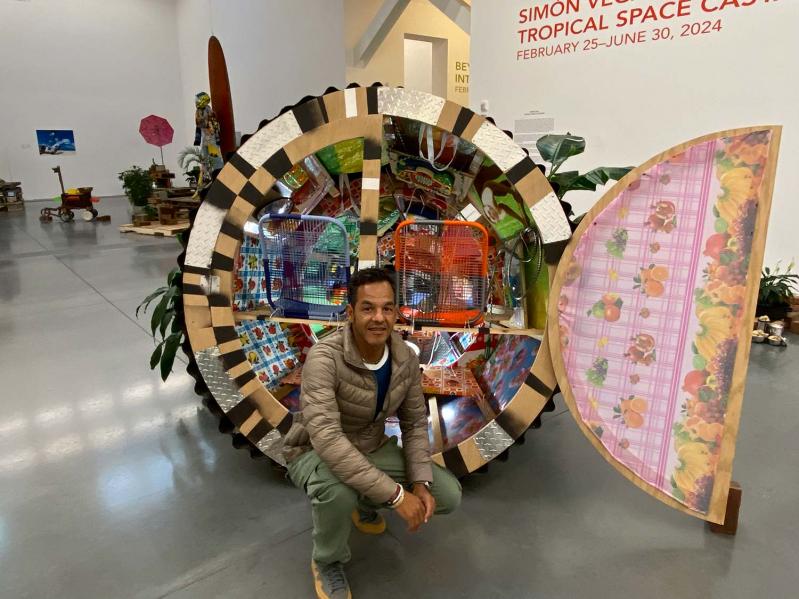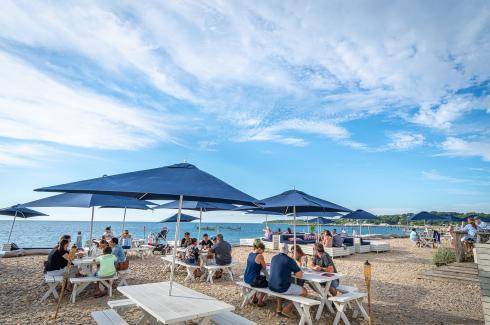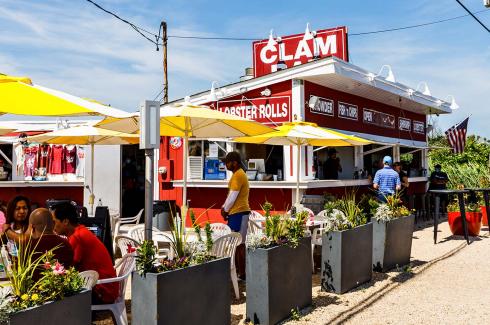The most dramatic component of Simon Vega’s “Tropical Space Castaways” exhibition at the Parrish Art Museum is “Tropical Mercury Capsule,” a NASA lookalike that appears to have crashed in the Water Mill museum’s large central gallery. But who are the castaways? Did they inhabit the four “Tropical Space Suits” on view, and, if so, where are they now?
On closer inspection, neither the materials of the capsule nor those of the spacesuits would pass muster with NASA, or, for that matter, with the space program of the former Soviet Union, both of whose archives figure in Mr. Vega’s research.
“In my practice I often play with opposites,” said Mr. Vega, who lives on the Pacific Coast in La Libertad, El Salvador. He creates detailed drawings of the space capsules, based on his research, “but the idea is to build it with materials that come from the everyday environment of El Salvador and Central America.”
He mostly uses found materials that often refer to local housing. “It’s very common to find corrugated-metal roofing sheets, and some modest houses are made entirely of them.” The capsule in the exhibition, in addition to the metal sheets, is put together from wood, found objects, lights, live plants — even plastic beach chairs where the astronauts might sit when not floating.
The use of mundane materials, Mr. Vega said, is “talking about poverty, but also science fiction and resourcefulness and creativity. I’m dealing with subject matter that’s serious and sometimes very dense, but there’s also a very humorous and colorful quality to the art because that’s how people in El Salvador and Central America deal with hardships, deal with the difficulties, and create possibilities.”
Identity, history, and politics are central to his work. “We have a local amnesia, we’re forgetting our history. But for me it’s important, and when I was thinking 10 years ago about how we came to where we are now, a lot had to do with our civil war in the 1980s, that lasted 12 years. But more importantly I found that that war had to do with a global situation — the Cold War.”
El Salvador was torn, he said, between Soviet and Cuban-backed guerrillas and a right-wing government that was backed by the Reagan administration. Because he didn’t want to engage with the politics in a dramatic or literal way, “I found the space race was a great way to talk about this competition, which seemed scientific but was also military. So how did that affect all these other areas?” Because a big war, a nuclear war, was unimaginable, “We had all these small wars in our countries.”
Each of the spacesuits is a mini-installation, with life-size figures mounted on wooden pallets and concrete blocks, heads covered with repurposed motorcycle helmets, and surrounded by plants, umbrellas, and, in one case, a large surfboard.
While the spacesuits are based on real NASA or Soviet-era suits, they are actually created from repurposed secondhand Hawaiian shirts. While doing the research, Mr. Vega discovered that these iconic “Aloha” shirts have nothing to do with Polynesian culture but were in fact created by the Japanese to sell as souvenirs during the 1950s. “Culturally, they have no connection to Hawaii.”
Those pieces engage with another theme important to Mr. Vega — tourism. “I use the shirts because I think they present us with this preconceived idea about Paradise that we tend to fall into when we are tourists. I’m really looking critically at tourism as recolonization, and that really connects also with space exploration and space colonization.”
Of the exhibition’s title, he said, “There was a space-capsule crash and then there are these beings coming from another place with their ideas of how things are. They’re exploring, they’re settling, and they’re adapting to the new environment, but also forcing the environment to adapt to them. It’s a very critical undertone to the very colorful spacesuits.”
Mr. Vega came to the attention of Monica Ramírez-Montagut, the Parrish’s executive director, through the agency of Mario Cader, an important collector whose Y.ES Contemporary foundation brings curators, museum directors, and artists to El Salvador to make studio visits.
“Monica visited us in El Salvador, we had time to chat, and we really connected. So, through Mario, I was able to be invited by Monica to do a solo exhibition here,” he said. Leading up to the exhibition, which opened in February and will be on view through June 30, he was in residence at Ma’s House and BIPOC Art Studio on the Shinnecock Reservation.
While staying there with Jeremy Dennis, the founder of Ma’s House and a prolific artist, “I became even more curious about the history of this area, this land, and the relation to the geography.” He had a residency at the Watermill Center as well, and is now active with the Parrish’s education department in workshops with nearby schools.
The one thing Mr. Vega hasn’t been able to do, in part because of time and in part because of the weather, is go surfing, a favorite pastime of his in El Salvador. But he has a friend here who keeps insisting that he must get into a wetsuit and ride the local waves. “Who knows? It might happen.”




